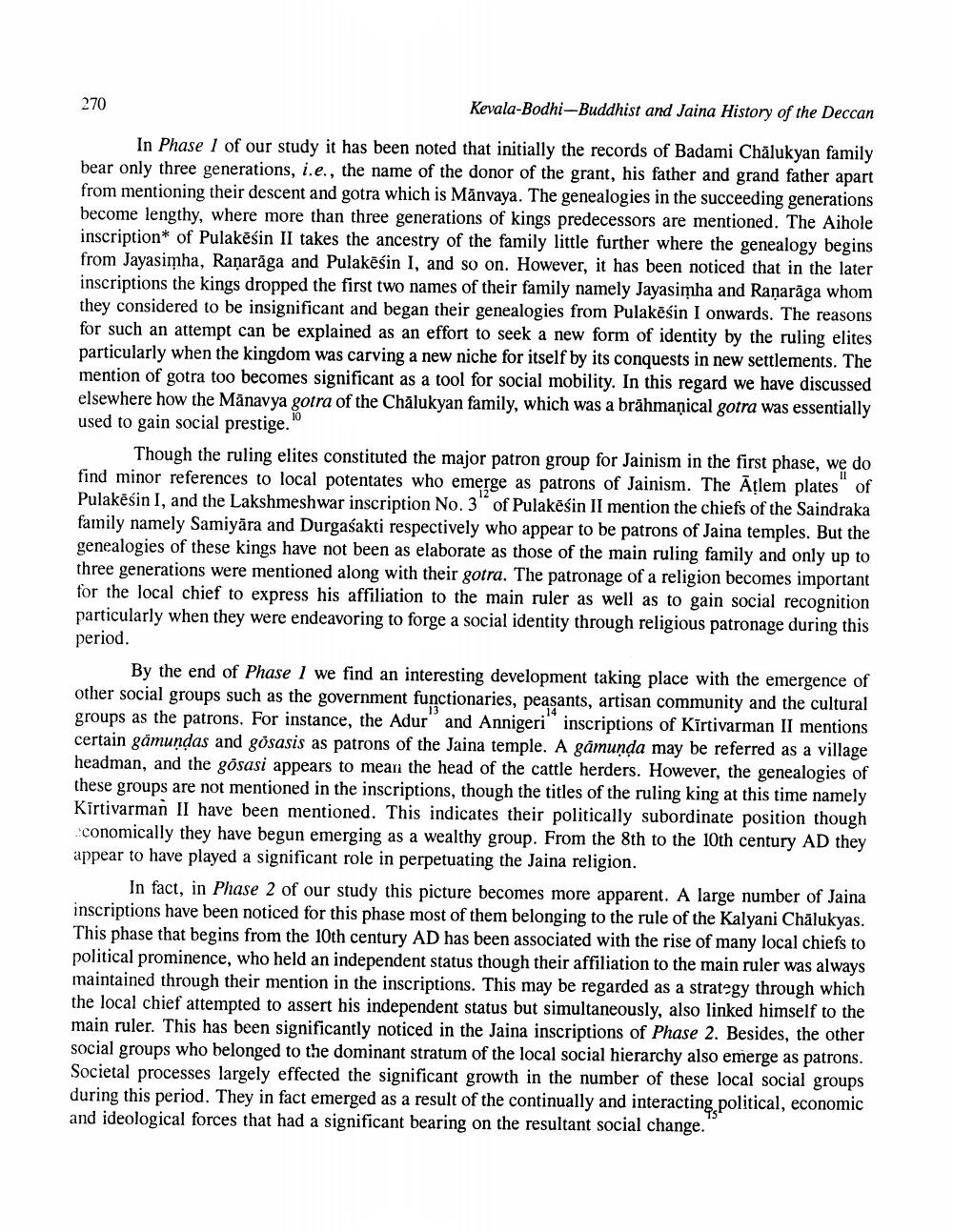________________
270
Kevala-Bodhi-Buddhist and Jaina History of the Deccan
In Phase 1 of our study it has been noted that initially the records of Badami Chālukyan family bear only three generations, i.e., the name of the donor of the grant, his father and grand father apart from mentioning their descent and gotra which is Mānvaya. The genealogies in the succeeding generations become lengthy, where more than three generations of kings predecessors are mentioned. The Aihole inscription* of Pulakēģin II takes the ancestry of the family little further where the genealogy begins from Jayasimha, Raņarāga and Pulakësin I, and so on. However, it has been noticed that in the later inscriptions the kings dropped the first two names of their family namely Jayasimha and Raņarāga whom they considered to be insignificant and began their genealogies from Pulakēģin I onwards. The reasons for such an attempt can be explained as an effort to seek a new form of identity by the ruling elites particularly when the kingdom was carving a new niche for itself by its conquests in new settlements. The mention of gotra too becomes significant as a tool for social mobility. In this regard we have discussed elsewhere how the Mānavya gotra of the Chalukyan family, which was a brāhmaṇical gotra was essentially used to gain social prestige."
Though the ruling elites constituted the major patron group for Jainism in the first phase, we do find minor references to local potentates who emerge as patrons of Jainism. The Āțlem plates of Pulakēśin I, and the Lakshmeshwar inscription No. 3 of Pulakēģin II mention the chiefs of the Saindraka family namely Samiyāra and Durgasakti respectively who appear to be patrons of Jaina temples. But the genealogies of these kings have not been as elaborate as those of the main ruling family and only up to three generations were mentioned along with their gotra. The patronage of a religion becomes important for the local chief to express his affiliation to the main ruler as well as to gain social recognition particularly when they were endeavoring to forge a social identity through religious patronage during this period.
By the end of Phase 1 we find an interesting development taking place with the emergence of other social groups such as the government functionaries, peasants, artisan community and the cultural groups as the patrons. For instance, the Adur" and Annigeri inscriptions of Kirtivarman II mentions certain gämundas and gosasis as patrons of the Jaina temple. A gámunda may be referred as a village headman, and the gosasi appears to mean the head of the cattle herders. However, the genealogies of these groups are not mentioned in the inscriptions, though the titles of the ruling king at this time namely Kirtivarman II have been mentioned. This indicates their politically subordinate position though
conomically they have begun emerging as a wealthy group. From the 8th to the 10th century AD they appear to have played a significant role in perpetuating the Jaina religion.
In fact, in Phase 2 of our study this picture becomes more apparent. A large number of Jaina inscriptions have been noticed for this phase most of them belonging to the rule of the Kalyani Chālukyas. This phase that begins from the 10th century AD has been associated with the rise of many local chiefs to political prominence, who held an independent status though their affiliation to the main ruler was always maintained through their mention in the inscriptions. This may be regarded as a strategy through which the local chief attempted to assert his independent status but simultaneously, also linked himself to the main ruler. This has been significantly noticed in the Jaina inscriptions of Phase 2. Besides, the other social groups who belonged to the dominant stratum of the local social hierarchy also emerge as patrons. Societal processes largely effected the significant growth in the number of these local social groups during this period. They in fact emerged as a result of the continually and interacting political, economic and ideological forces that had a significant bearing on the resultant social change.




